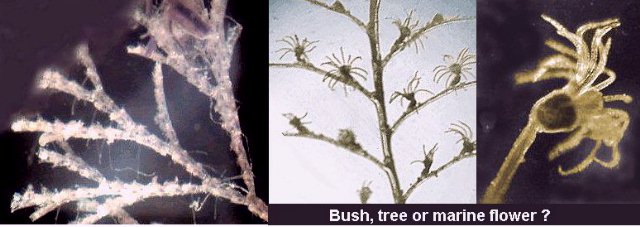 |
|
BRYOZOANS AND CNIDARIANS |
|
||||
| When we are looking at the marine world, we find some animal species which mimic plant life. Often marine algae, mussels, or even boat hulls, are colonised by small plant-like creatures. They form bouquets, bushes, even minuscule trees, or grow alone as small 'flowers' bending in accordance with the water flow (picture below). Everybody knows the sea anemone - which, of course, is not a flower! But there are also other fascinating plant-like marine organisms. |
 |
| Some of these critters are
common species of bryozoans or cnidarians and they are easy to find along
sea coasts on various surfaces, including boat hawsers or submerged ropes;
these are interesting habitats for us as there's no need for a deep dip
to catch them! Only a few are freshwater creatures; the sea is their favourite
habitat. There are around 5000 living species today but much more in past
times (e.g. the Triassic and Permian eras in Earth's history).
Although they have some similarities, the Bryozoa and Cnidaria are two different phyla. At first sight, with the naked eye or with a handheld low power magnifier, their organisation seems to be the same, clearly showing a composite structure with many individuals, called zooids. When you are starting to study marine life, it's easy to confuse the two. But when we use a microscope, we can discover their delicacy of details and subtle differences. If kept undisturbed in seawater, individuals come out from their protective envelope and deploy tentacle rings. |
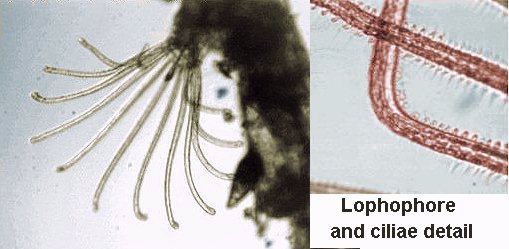
Bryozoan showing ring of tentacles (the lophophore) and detail. |
| Bryozoans are discussed in this page and cnidarians in the following page. They differ mainly in tentacle organization; for bryozoans they are arranged in a crown around the mouth and are ciliated (see detail above), whereas for cnidarians they are not ciliated. This tuft of tentacles is called the lophophore and can be retracted quickly by a strong muscle fixed into the envelope. Cilia movements conduct food particles down toward the mouth. (See videos). Each feeding zooid is interconnected with the others through the stem and "U" shaped digestive system and can sometimes be seen when the exoskeleton is not too calcified. The anus is at the external end of the "U" and emerges outside of the lophophore. (See picture below). | |
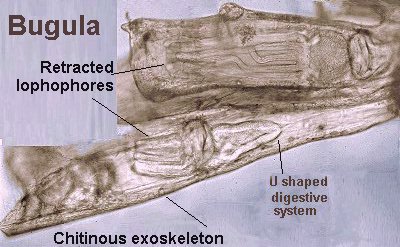 |
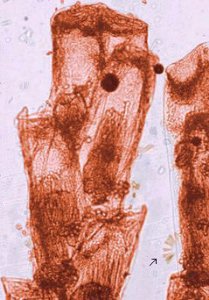 |
| Right hand picture: eosin stained and mounted specimen. Note the diatoms fixed on it (arrowed). | |
| Some zooids are specialized to catch food particles (gastrozooids), others into reproductive processes (gonozooids). Indeed reproduction is both sexual (i.e. eggs and sperm are produced separately to give a swimming larva), or asexual by budding on the stem. | |||
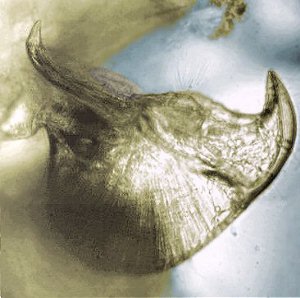 |
Other
specialized zooids are very intriguing in some species like bugulas: These
zooids are called avicularia, are located on the stem sides and are used
to protect the colony against some invaders or fouling organisms e.g. worms
and larvae. The name's origin is probably because they look like a bird's
beak. (Don't miss seeing the video clip!
… impressive isn't it?) Normally avicularia adopt an open 'beak' but sometimes
the beak is quickly closed, maybe when an object touches a tuft of hairs
located in the middle. Yet bugulas tolerate well any vorticellas or suctorias
that are present.
The picture left shows an avicularian on a Bugula species. |
||
| In other species of bryozoan, 'protective' individuals called vibracula have the shape of a long bristle which moves like a whip, (see arrow on picture left below); other species have protective spines at the open end of a branch (picture right below). | |||
 |
|||
| Reproduction gives rise to rounded ovicells, called ooecia. Often you can see a single egg in each ooecium. See the picture below which also shows free swimming ciliated larva. When the colony becomes older, some individuals near the stalk base, contract and only ovoid brown masses can be seen inside the stall. | |||
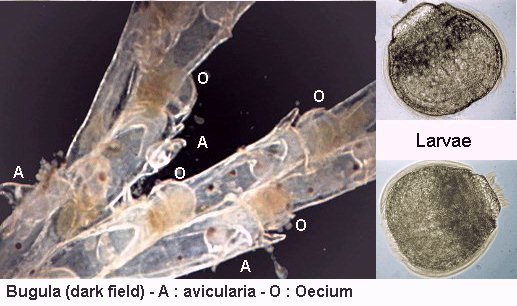 |
Ooecium and larva.
(Mounted slide.)
Right side: Detail of live swimming larva. |
||
| In Zoobotryon species, (pictures below), feeding zooids (or autozooids) are more widely spaced and between them the 'stem' has kenozooids, or other specialised individuals. This stem looks like a stolon in plants, and may reach 0.5 m in length and more! One specimen I found was more than 80 cm long. Kenozooids are not calcified and present a sort of turgidity as they are under pressure; if you pierce them, the stem becomes flaccid. It's a pest in some harbours, because large bushes can block pipes used to pump seawater. If you break a fragment of it, in a few days some 'branches' appear and try to fix themselves on the bottom of the jar by a sort of clamp. | |||
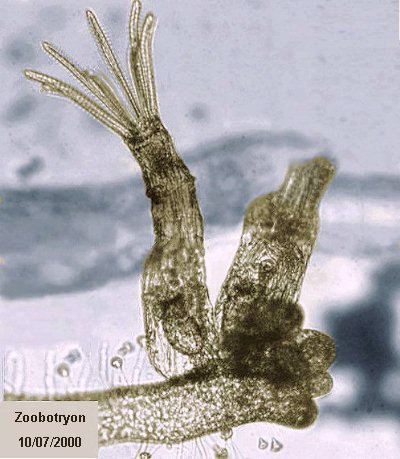 |
Note
the buds at right end of stolon.
The stem is colonised by vorticella. Below: Detail of 'clamp'. |
||
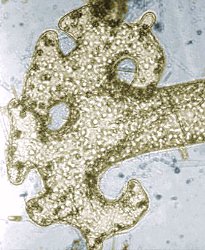 |
|||
|
|
|||||||||||||||
|
Microscopy
UK Front Page
All photographs © Jean-Marie Cavanihac 2000 Published in the May 2001 edition of Micscape Magazine. Please report any Web problems or offer general comments
to the Micscape
Editor,
Micscape is the on-line monthly magazine of the Microscopy
UK web
|